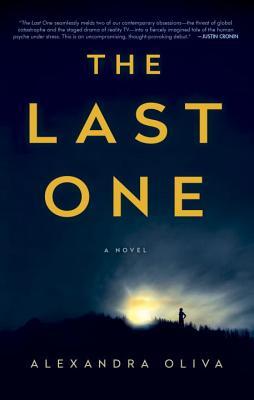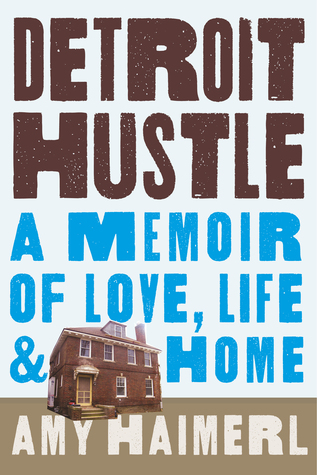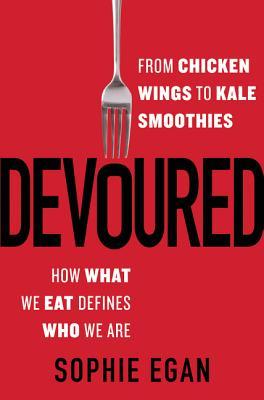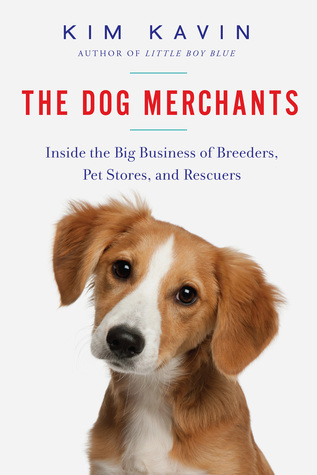
The Last One by Alexandra Oliva
Zoo is a contestant on a survival reality TV show. Some of the show's challenges are group challenges and some are solo. While on a solo challenge Zoo's cameraman never shows back up, but she thinks it's part of the challenge that there are hidden cameras. But, the reality that Zoo doesn't know is that her cameraman is dead - a pandemic has hit the US and hundreds of thousands of people die. But, Zoo still thinks she is on the solo challenge. When she starts seeing some of the carnage she thinks it's just part of the show. After meeting Brennan, a teenager who's family all died, she finally realizes what has happened. Zoo's hope is that somehow against all odds her husband survived. Will she and Brennan make it back to her home? Will her husband still be alive?
This is a really unique storyline and it was definitely a quick read. The beginning was a little slow, but once the story picked up you didn't want to put the book down. This is the author's first novel, so I'll be interested to see her future books.
This is a really unique storyline and it was definitely a quick read. The beginning was a little slow, but once the story picked up you didn't want to put the book down. This is the author's first novel, so I'll be interested to see her future books.

Detroit Hustle: a memoir of love, life, and home by Amy Haimerl
Amy Haimerl grew up in a small, working-class town in rural Colorado, so blue collar, hard scrabble towns are in her blood. While she and her husband are living in Red Hook Brooklyn where the cost of living is getting higher and higher, they decide to start looking for somewhere to live where they can afford to buy a house. They end up in Detroit. And while rumors of $1 houses in Detroit abound, there is a lot of red tape involved in buying and fixing up an abandoned house in Detroit...namely most banks won't give you a mortgage. After finding their dream home and cashing out their 401ks and borrowing money from family they spend two years rehabbing a historic home in Detroit. Amy writes about not only their adventure in renovating a home, but also some of the history and current issues with Detroit. She also delves into the whole issue of gentrification and what that can mean for both sides of the issue. Overall, an interesting book about how one couple realized their dream of home ownership and are helping to revitalize the city of Detroit.

Salt, Fat, Acid, Heat by Samin Nosrat
This is a unique cookbook in that only about half of the book is recipes. The first half talks about the four main elements of cooking - Salt, Fat, Acid, and Heat. Each chapter explains that element and how it affects cooking. She also includes "test" recipes to test out each element and using that element when cooking. The second half of the book is full of recipes and then at the very end she creates some sample menus based on the recipes given. This is more like cooking school in book form. Michael Pollan writes the forward and I remember Samin being featured in his book Cooked when she teaches Pollan how to cook better. Overall, a very thorough and educational book about cooking. This is one you could refer back to time and again and learn something new each time.

The Alliance by Jolina Petersheim
When a plane crashes into a Mennonite community in rural Montana it signals a drastic change for this pacifist community. Moses Hughes, the pilot of the crashed plane, believes that an EMP or electromagnetic pulse is the cause of his plane crash and the loss of electricity in the area. But, as the Mennonite community only uses electricity for their commercial store, they are the most prepared people in the area - which means they quickly become a target for gangs of looters and thieves. Moses and two other Englishers (non-Mennonites) work with the Mennonites to try to protect their community.
While I liked the premise of the book, it was VERY obvious right from the start that a large focus of the book is the love triangle between Mennonites Leora and Jabil and the downed pilot Moses. It was also painfully obvious that Moses, like his Biblical namesake, was "sent" to lead the Mennonite community out of danger. There was also a very odd twist at the end relating to Leora's estranged father that really seemed crazy and did not fit with the rest of the book. But, it was still a quick read and I'll admit that I put myself on hold for the sequel since the ending definitely leaves you hanging. This is like the Hallmark movie channel version of a dystopian novel, which I would normally not like, but it did draw me in enough to keep reading and I do want to see what happens in the next book.
While I liked the premise of the book, it was VERY obvious right from the start that a large focus of the book is the love triangle between Mennonites Leora and Jabil and the downed pilot Moses. It was also painfully obvious that Moses, like his Biblical namesake, was "sent" to lead the Mennonite community out of danger. There was also a very odd twist at the end relating to Leora's estranged father that really seemed crazy and did not fit with the rest of the book. But, it was still a quick read and I'll admit that I put myself on hold for the sequel since the ending definitely leaves you hanging. This is like the Hallmark movie channel version of a dystopian novel, which I would normally not like, but it did draw me in enough to keep reading and I do want to see what happens in the next book.

Devoured: from chicken wings to kale smoothies how what we eat defines who we are by Sophie Egan
In Devoured Sophie Egan explores the deeper meaning behind what we choose to eat and why. What does is say about our country that only 26% of Americans eat breakfast everyday and 40% eat lunch at their desk so they can keep working? Egan explores not only how we eat, but some of the crazy things we eat like cereal that has more sugar than candy bars and things like the Doritos Locos Taco from Taco Bell. Egan explores 10 phenomena that illustrate what our food says about who we are as a culture. In the last chapter she gives her prescription for how we can create better food habits and culture - "Work less and savor more. Make it real and stir the pot." (p. 311). This is a very interesting look at America's food culture and habits and it really does say a lot about who we are both for good and bad. I liked that Egan shows her findings, but doesn't pass judgement about what we should or shouldn't be eating. She isn't telling us to give up sugar forever, but what she explores does shine a light on some bad habits that could be better. Overall, a great book with tons of eye-opening information.
Here are some quotes I really liked:
"I was on a hike with a Swedish friend, and she was talking about how stunned she is by the amount of time people work in the United States...she asked me a simple question about the sheer number of hours we work: Why? She was absolutely dumbfounded when I explained: Putting in the time proves your value. She laughed at the idea and said, 'In Sweden, if you're working more than the hours absolutely mandatory and expected of you, people's reaction is, 'What's wrong with you that you couldn't get your work done in time?' ' In other words, it's an efficiency question - 'You're working late tonight? Oh, you must be slow.' I stopped in my tracks. Mind blown." (p. 27)
"When [consumers were asked] how they define a 'meal,' they describe a combination of foods, home-cooked and plated. This sounds about right to me too. But when he asks them the last time they had a meal like that, responses vary from 'a couple of weeks ago' to 'maybe Thanksgiving.' One of the fundamental themes of eating behavior is that there is a difference between what people say they want and what they actually eat. It's often the difference between intention and action, between goals and reality." (p. 29)
"Dinner has become a litmus test for family values in America. According to recent data from Gallup, 53 percent of American adults with children under the age of eighteen say their family eats dinner together at home six or seven nights a week. On average, families share 5.1 dinners together, down only slightly from 5.4 in 1997...I'll admit, this figure is higher than I would have given us credit for...But if you dig deeper into the family meal, it gets more interesting...It turns out that a good number of families eating dinner 'together' aren't eating the same thing. Family meals are following more of an a la carte model...More than half of families cook multiple meals or dishes to cater to each family member." (p. 97-8)
"...our food culture thrives on 'mass customization,' which sounds like an oxymoron but means taking existing processed foods and delivering them in individual-size portions that meet a wide range of specific demands. A cup of coffee made with a Keurig capsule costs about three times more than one made with supermarket grounds and a drip machine. That Keurig habit can add up to spending $400 more on coffee in a given year. Apparently the exact flavor we get from Keurig, made fresh at the precise moment we want it, is worth that much." (p. 103)
"...a far more prevalent, and equally puzzling, practice: Selling Absence. That is, how marketers convince us to buy foods such as fat-free milk, low-sodium pretzel sticks, and 100-calorie packs of cookies. What we are doing is purchasing a food not for the crazy reason that it contains worthwhile ingredients - but because of what an item lacks. Emily Green, a writer for the Los Angeles Times, has dubbed this genre of foods 'nonundelows,' because their labels being with 'non-,' 'un-,' 'de-' and 'low-.'" (p. 107)
"So when it comes to brunch, one way to think about its popularity is to ask what activity it is replacing. If people are sipping mimosas at a cafe with friends, what are they not doing on Sunday mornings? The answer: Brunch is secular church. Sunday service for the socially starved. Something for the nothings. Specifically, something soulful and restorative...in parts of the United States where people aren't as religious, the brunch gathering is the closest substitute for the experience of church: getting out of the house, marking the turn of the calendar, breaking bread together. Perhaps most important, Connor argues, it involves spending time with friends or family." (p. 145)
Here are some quotes I really liked:
"I was on a hike with a Swedish friend, and she was talking about how stunned she is by the amount of time people work in the United States...she asked me a simple question about the sheer number of hours we work: Why? She was absolutely dumbfounded when I explained: Putting in the time proves your value. She laughed at the idea and said, 'In Sweden, if you're working more than the hours absolutely mandatory and expected of you, people's reaction is, 'What's wrong with you that you couldn't get your work done in time?' ' In other words, it's an efficiency question - 'You're working late tonight? Oh, you must be slow.' I stopped in my tracks. Mind blown." (p. 27)
"When [consumers were asked] how they define a 'meal,' they describe a combination of foods, home-cooked and plated. This sounds about right to me too. But when he asks them the last time they had a meal like that, responses vary from 'a couple of weeks ago' to 'maybe Thanksgiving.' One of the fundamental themes of eating behavior is that there is a difference between what people say they want and what they actually eat. It's often the difference between intention and action, between goals and reality." (p. 29)
"Dinner has become a litmus test for family values in America. According to recent data from Gallup, 53 percent of American adults with children under the age of eighteen say their family eats dinner together at home six or seven nights a week. On average, families share 5.1 dinners together, down only slightly from 5.4 in 1997...I'll admit, this figure is higher than I would have given us credit for...But if you dig deeper into the family meal, it gets more interesting...It turns out that a good number of families eating dinner 'together' aren't eating the same thing. Family meals are following more of an a la carte model...More than half of families cook multiple meals or dishes to cater to each family member." (p. 97-8)
"...our food culture thrives on 'mass customization,' which sounds like an oxymoron but means taking existing processed foods and delivering them in individual-size portions that meet a wide range of specific demands. A cup of coffee made with a Keurig capsule costs about three times more than one made with supermarket grounds and a drip machine. That Keurig habit can add up to spending $400 more on coffee in a given year. Apparently the exact flavor we get from Keurig, made fresh at the precise moment we want it, is worth that much." (p. 103)
"...a far more prevalent, and equally puzzling, practice: Selling Absence. That is, how marketers convince us to buy foods such as fat-free milk, low-sodium pretzel sticks, and 100-calorie packs of cookies. What we are doing is purchasing a food not for the crazy reason that it contains worthwhile ingredients - but because of what an item lacks. Emily Green, a writer for the Los Angeles Times, has dubbed this genre of foods 'nonundelows,' because their labels being with 'non-,' 'un-,' 'de-' and 'low-.'" (p. 107)
"So when it comes to brunch, one way to think about its popularity is to ask what activity it is replacing. If people are sipping mimosas at a cafe with friends, what are they not doing on Sunday mornings? The answer: Brunch is secular church. Sunday service for the socially starved. Something for the nothings. Specifically, something soulful and restorative...in parts of the United States where people aren't as religious, the brunch gathering is the closest substitute for the experience of church: getting out of the house, marking the turn of the calendar, breaking bread together. Perhaps most important, Connor argues, it involves spending time with friends or family." (p. 145)

The Stars Are Fire by Anita Shreve
In October of 1947 after a long drought fires break out all along the Maine coast. Grace Holland and her husband Gene live 2 blocks from the ocean with their two children. When the fires break out Gene and some other men go try to create a firebreak to stop the fire from reaching their community. When the fire comes Grace and her children must huddle in the ocean to stay alive while they watch everything they own burn to the ground. Grace has no idea if her husband survived the fire or not, but she has to step up to care for her children. In short order Grace finds a place for them to stay, learns to drive, and gets a job. But months after the fire when her husband returns neither of them is the same. Grace has come to relish her independence and control over her own life and Gene is terribly burned and disfigured from the fire. While their marriage was never good, the stress of Gene's injuries really brings out the worst in him and he takes it out on Grace and their children. Grace found strength within herself to rebuild her life after the fire, but can she find the strength to leave her abusive marriage and start over yet again. Grace finds that her experience has irrevocably changed her and even if she wanted to she can never go back to who she was before the fire.
A beautifully written and haunting novel about finding the strength and resilience to start over.
A beautifully written and haunting novel about finding the strength and resilience to start over.

The Dog Merchants: inside the big business of breeders, pet stores, and rescuers by Kim Kavin
Some quotes I really liked:
"'To me, breeds are like a designer handbag,' Woods writes. 'People like the way they look and the hype behind them. They buy into the stereotypes (Border Collies are the smartest, Labs are the most faithful, etc.) and then they match up how they see themselves with the marketing behind the dog.'" (p. 49)
"All dog lovers have come to know the terms 'puppy mill' and 'puppy farm' in recent years. They appear on the news and in fundraising letters from animal welfare groups showing horrific photographs and asking for donations to shut down the big-scale breeders who treat dogs badly...But what, exactly, is a puppy mill? There is no legal definition, even according to leading animal welfare groups." (p. 89)
"The notion that America's homeless dogs face an 'overpopulation problem' does not match up against the available statistics. Supply is not exceeding demand. Americans want about eight million dogs a year as new pets, while only about four million dogs are entering the shelters. America kills about two million of those shelter dogs each year while US dog lovers get their new pets from other sources. If just half the Americans already getting a dog went the shelter route, then statistically speaking, every cage in US animal control facilities could be emptied. Right now. And the United States would still need another four million dogs each year to meet demand. Americans want more pups than any other nation on the planet. In the United States, there are no extra dogs in terms of quantity. There are instead millions of throwaway dogs in terms of perceived quality." (p.140-1)
"'This is a very materialistic society. If you buy something and then you don't want it, you throw it out,' [Teri Goodman] says. 'I was walking on the street with Misty one day, and there was a woman who said a woman up the block wanted to get rid of her older dog. I said, 'What's the problem? Is the dog unhealthy? Is there a problem with finances?' And the woman said she was selling her house and moving to an apartment, and she had a garden and could let the dog out, but at the apartment, she'd have to walk her. The dog was fourteen. She'd had her from a puppy. Now that I've been in this senior dog world for a while, that's not an uncommon story. People think of a dog as a commodity, that you can get rid of it if it's inconvenient.'" (p. 203)
No comments:
Post a Comment